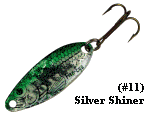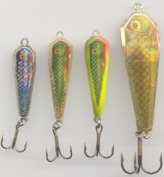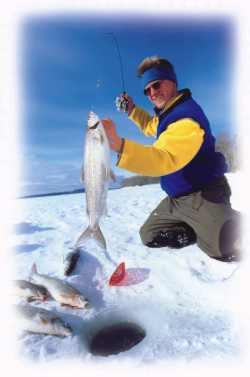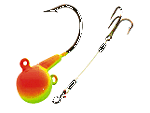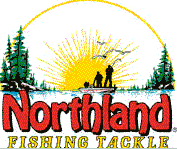
|
|||||||||||||||||||||

Look as Sharp as your hooks Click here for the latest in Walleyes Inc. outdoor wear Promotional Team Favorites Lodging food and more 
Free 90 day Risk free trial offer click here 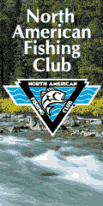
|
By Tommy Skarlis Largemouth Bass
As rudimentary as it sounds, the chief criterion is finding a body of water with considerable numbers of bass, and usually, those are destinations with limited pike. Most of these waters are heavily weeded and riddled with bays and backwaters. Weeded bays provide prime habitat for hardwater bass, especially at first and last ice, and those are your best periods for hooking fish anyway. Historically, bass activity spikes at first ice, wanes as the shallows lose greenery and oxygenation, and fires up again during late ice – pay attention to season closures in your area. Bass are weed-loving critters, and at no time is this more evident than first ice. Search right in the thick of things, giving added mindfulness to pockets, lanes, and heavy weedlines. Submerged timber and weed covered humps can also harbor bass. And there’s a strong chance of finding bucketmouths anywhere masses of sunfish reside.
Stationary tip-ups provide tremendous support to jigging. On Ice Tour contributor, Brian “Bro” Brosdahl learned a technique from fellow guide Dick “Griz” Gryzwinski. It’s simple. Put the jigging rods down and put trust in a field of tip-ups. Bro rigs a squadron of Finicky’s Fish Factories with single, wide-gapped hooks and a lively shiner minnows. Shiners out-fish all other minnows 10 to 1, including suckers and chubs. With bass, Bro and Griz are firm believers that you catch more fish by sitting tight; properly placing tip-ups; moving a legal distance away, and not tromping around. Rare are the moments when these guides aren’t carrying jigging rods, but this is one. Catfish
On rivers, seek out the deepest holes. Sometimes that means slackwater sections away from the main channel, and in other situations cats nest in the heart of the channel, especially in widened stretches with limited current. Reservoirs that feature old river channels can be catfish havens. Look for bends and drops in the channel – slight three, four, and five-foot depressions are sometimes all it takes. Deep holes positioned off shoreline points also warrant exploration. Many consider catfish to be crows of the waterways, eating only expired morsels. Although cats will take dead bait, I’ve personally had better results with live minnows. Rig one tip-up with an active minnow and fair sized hook, and situate it just inches from the bottom. In hazardous timber, I tie on Lindy No-Snagg Hooks; Chip likes the visual stimulation of Northland Super-Glo Attractor Hooks. Fix dead bait on another line, maybe a cut sucker or smashed shiner minnow, and squirt it with Berkley Catfish Attractant – that’ll test their sniffers. Another trick is pegging a Northland Firelight Glow Stick or Lindy Glow Stick Float Night Light a couple of inches above the bait, adding visual stimulation. After all, catfish are known night feeders, so give them every opportunity to zero in on your bait. On Ice Tour contributor, Glen Schmitt partakes in a hardwater cat or two. “One of the weirdest things I’ve noticed is that catfish suspend when they’re active, sometimes mixing with crappies. I attack suspended catfish with jigging spoons and minnow heads.” Schmitt finds his suspended kitties over deep holes, ones he describes as “wintering holes”. And he notes that late winter seems to produce best, and that’s good, because gamefish seasons are closed in many regions, thus affording you another crack at big fish. Eelpout Sometimes the Swan Song, the arrival of eelpout marks the end of a walleye
bite. True, it does happen, but that doesn’t mean the enjoyment has
to end. Love the “ling” and labor for “lawyers”! If you consider
eelpout to be part of the complete ice fishing experience, their status
improves, and you might quit building picket fences with the frozen ones.
Catching wintertime ‘pout, like cats, is more about spots than baits, but I do have some favorite presentations. First off, eelpout are drawn to luminescence. Creatures of the night, eelpout love freshly glowed phosphorescent jigs, so long as a minnow’s included, like a rainbow or large fathead.
Arm yourself with the stuff of gladiators, including steadfast line, rod, and reel. Berkley’s Fireline Ice provides strength and sensitivity for big fish in deepwater. The same company’s Dave Genz Signature Lightning Rod (36-inch, medium-heavy) flexes and feels like a six-footer, and you can’t beat the smoothness and reliability of Abu Garcia baitcast reels. Whitefish & Tullibee Tullibee are actually ciscoes, and ciscoes are whitefish, but whitefish aren’t tullibee or ciscoes. Got it? Whitefish are a family, which includes lake whitefish, specifically, as well as ciscoes, and in some regions, anglers call tullibee, ciscoes. Whitefish grow large, commonly reaching into the sixes and sevens, but their range is limited to some degree. Whitefish inhabit numerous Canadian lakes, border waters, and various large and deep lakes on the stateside. Ciscoes coexist in many of the same lakes, but also range further south and are more widely distributed. Prioritized, whitefish and ciscoes are food before fight, meaning their luscious and high calorie bodies provide nourishment to other fishes. Walleyes, pike, and lake trout grow large on diets of whitefish. Their second attribute is fight, because inch for inch, whitefish and tullibee pack tons of punch. Numero three on the list of attributes is willingness to bite – they feed frenzy-style. Volume goes hand in hand with willingness, because whitefish of all shapes and sizes forage in packs, sometimes gigantic schools. Lastly comes taste, ciscoes are tremendous when smoked, in fact I’ve actually snacked on smoke-cooked ciscoes while simultaneously jigging for them, which is sort of sadistic. Lake whitefish even make good on the grill, fryer, and in the oven. Tullibee are one of nature’s easiest fish to find, and make strike. On Ice Tour’s Chip Leer first checks deep pockets, particularly during mid and late winter, when tullibee really hole up. His best spots lie near structure, like points and reefs. Schmitt also favors deep water, to which he adds flats, and the fact that ciscoes commonly suspend midway through the water column, but will yo-yo high and low to attack – whitefish species have exceptional vision. Due to their suspending nature, whitefish and tullibee are easily tracked on a flasher, and electronics are essential to the search. And that Superman-like eyesight makes them prime candidates for precision tackle by Lindy and Northland. Schmitt jerks ciscoes and whitefish with a #8 or #10 Genz Worm and maggots – bigger panfish sizes. Leer prefers a Creep Worm or Forage Minnow Fry, and he also attaches live maggots or Power Wigglers. In essence, an effective panfish system is applicable to whitefish and tullibee. Lure, line, rod, and reel selection are transferable, as well as jigging methods. Go light and enjoy the fight! We’re not trying to convert you into a freakish, alternative angler who won’t be satisfied until icing a paddlefish, gar, and lamprey eel. No, instead, On Ice Tour just hopes you’ll appreciate so called hardwater exotics, sometimes fish for them, but never again treat them like junk fish. Editor’s note: ON ICE TOUR – cofounded by Chip Leer and Tommy Skarlis – is an intensive effort aimed at expanding the sport of ice fishing through instructional articles, seminars, in-store and ice fishing contest appearances, and one on one exchanges with the public. Learn more about ON ICE TOUR and the greatest of winter sports at http://www.onicetour.com Special thanks to On Ice Tours Sponsors
Fish Clix Banner Exchange Please visit these site sponsors |
||||||||||||||||||||
|---|---|---|---|---|---|---|---|---|---|---|---|---|---|---|---|---|---|---|---|---|---|
